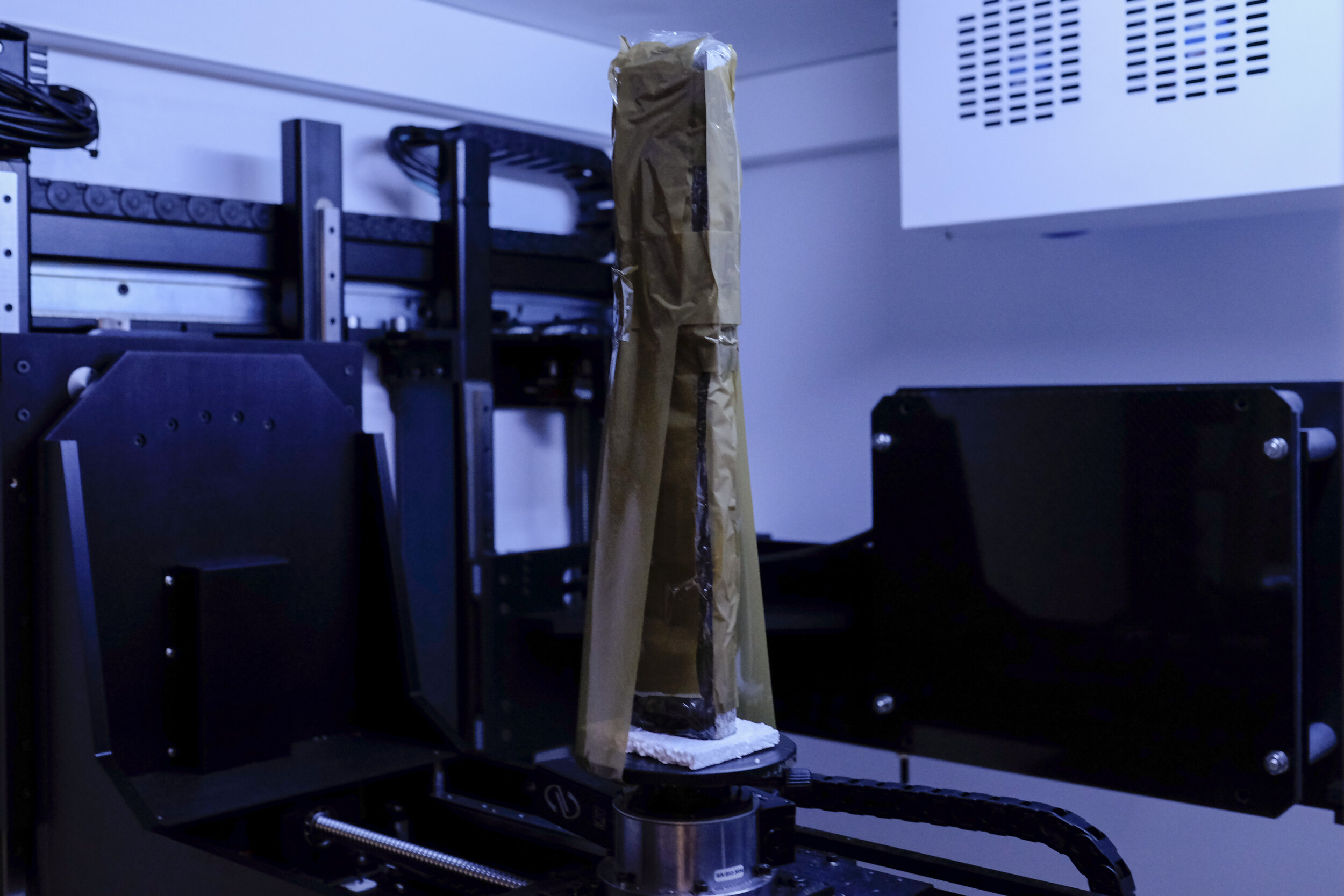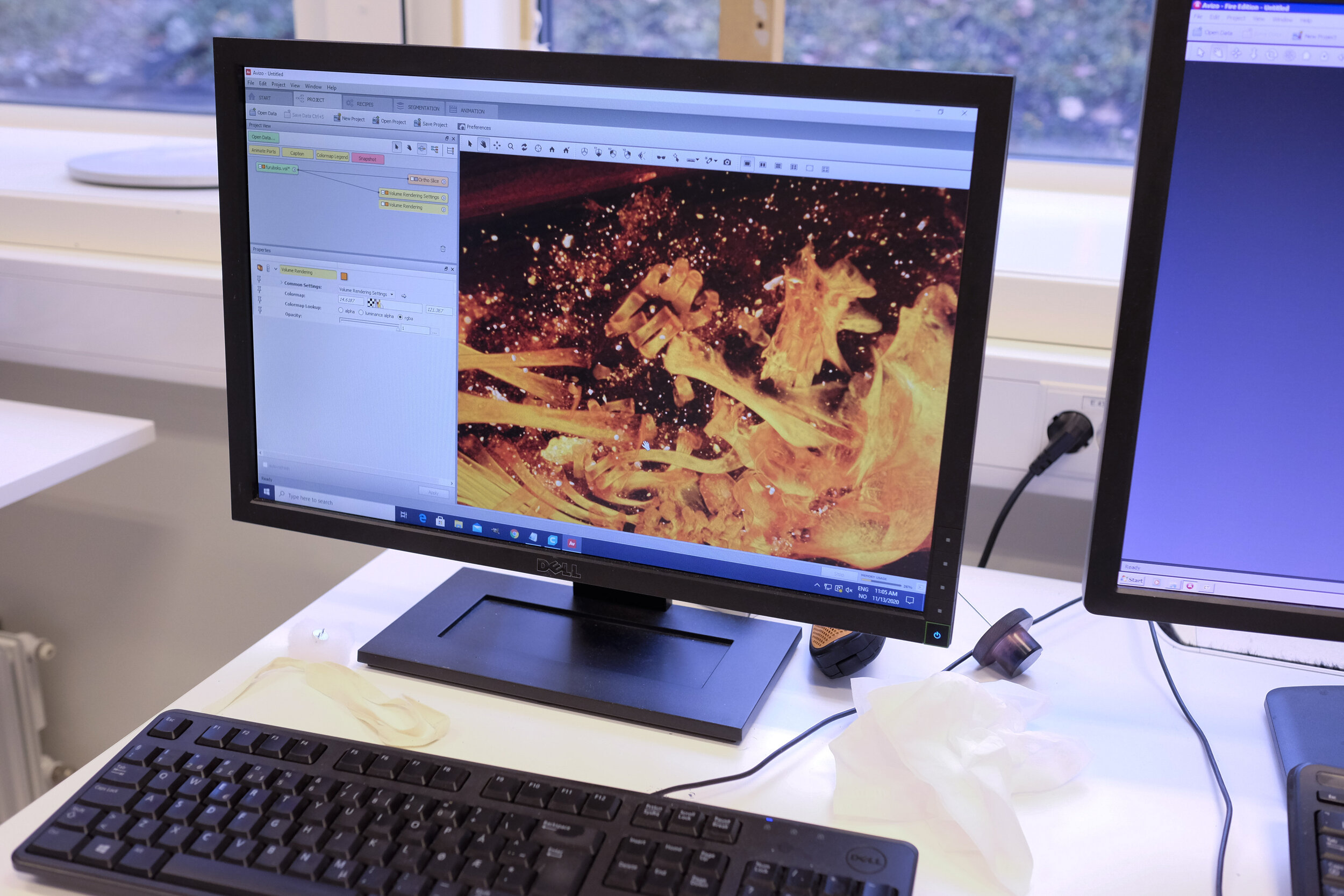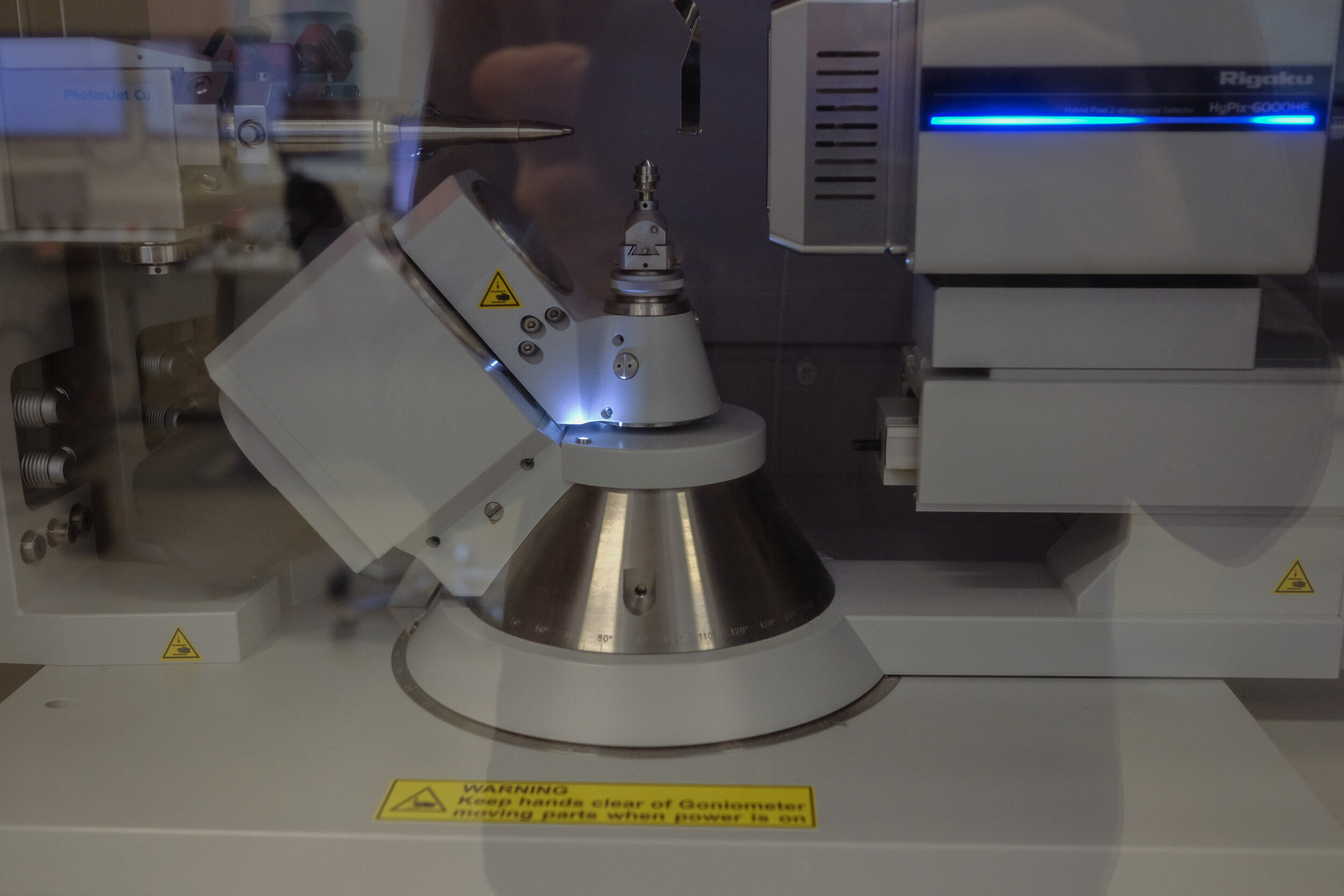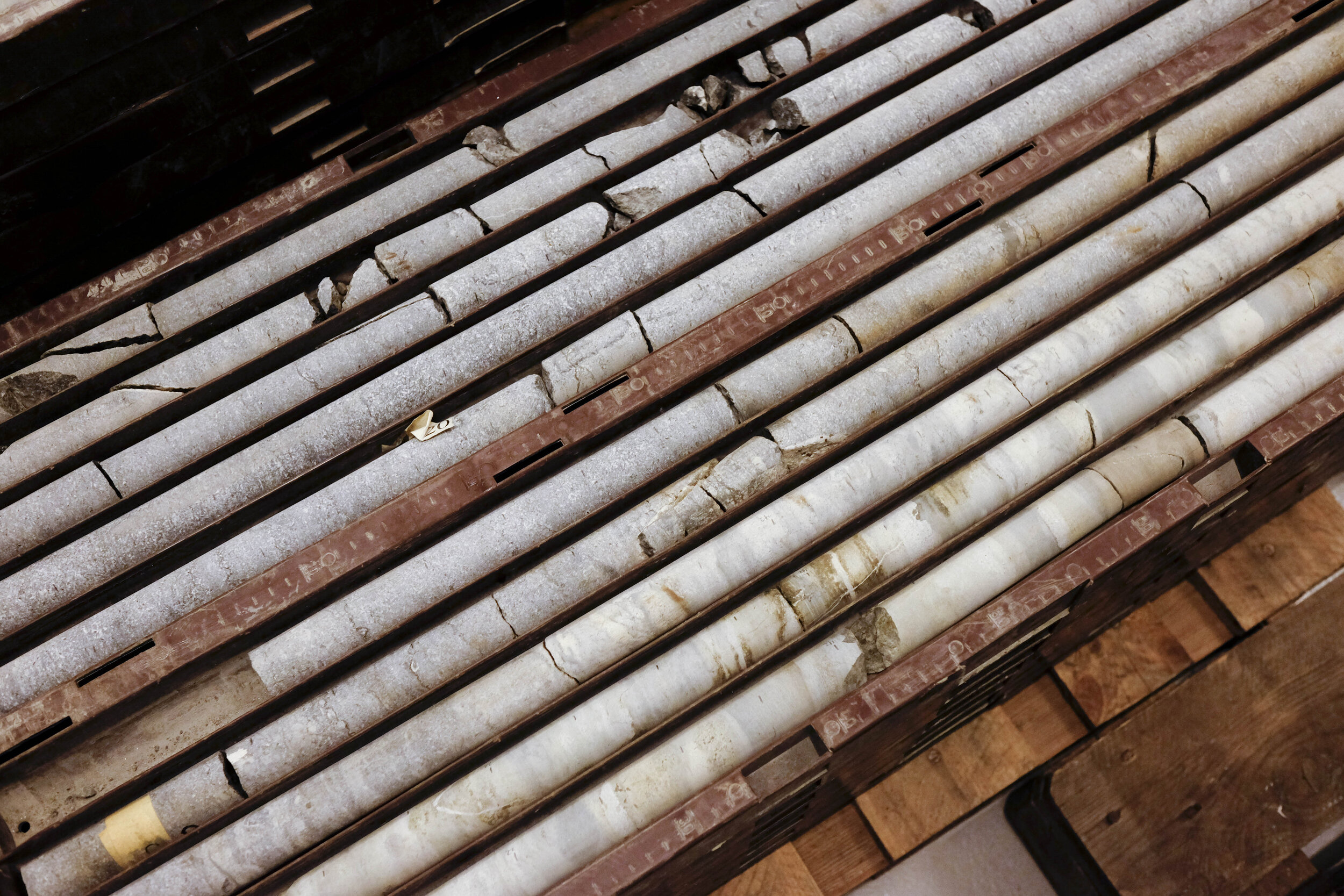Object focus: Carbonate
Carbonate formed by methane eating bacteria. Collected from ca 300m depth at Troll gas field in the North Sea (2006)
Studio process: Post petroleum landscape
The post petroleum landscape
Residue from 2nd year curriculum book, BA petroleum engineering, University of Stavanger.
(Aquired from student Nina Egeland, April 2021)
ESSAY: Petroleum drill bits on the second-hand market
At Finn.no, the Norwegian internet-based used market, there is a small niche for used drill bits, most of them originating from drilling oil wells in the offshore operations off the coast of Norway. They come in many sizes spanning from smaller versions weighing from 2-5 kilos, to very large ones at over 100 kilos. Most of them are sold by men who have some kind of connection to the petroleum industry. They might be retired offshore workers or mechanics; others might have been given the drill bits as a gift from others. It is not a communal market, and it is unknown how many of the sellers are aware about each other.
These objects literally spearhead the action of drilling. Because of this they are extremely robust, hardened and solid objects made from steel. They are mounted at the end of drill probes, and with the use of a mechanism their crowns spin around while being fed with a drill fluid that eases the drilling process. It is achieved by cooling it down and creating alluvium, a mix of mud and fluid that makes the drilling more efficient. They travel to and from oil rigs for deployment and repairs, before they in the end are retired. Once retired they seem to find their way to the men who worked with them, to museums or even oil company`s headquarters.
They also make a journey in terms of value. They are manufactured and put to use as high-quality equipment with instrumental value, drilling wells and making sure that petroleum resources become available and extractable. After their drilling lifecycle ends, their purpose become more undesignated. It is obvious that they have been of great importance, and this suggests that they should be commemorated and kept. They thus assume more of a symbolic status, as monuments, totems or even icons of the endurance an achievements of the industry and the hard labour of the workers on the rigs. They have endured weather, raw oil, dirt and long hours to make sure that the state petroleum of the people of Norway, is found and brought to the surface.
The workers who get the chance to bring a drill bit home and seem to have the idea to use it as a symbol of their connection to the oil industry. But the drill bits at Finn.no are presented not only as monumental, symbols of industrial heritage but also as potential decorative objects. They might be turned into chandeliers, flowerpots or ash trays. Some are sandblasted and covered with gold paint.
But in many of the cases where they are sold on Finn, they have become idle, ruinated objects, lying around rusting in gardens or garages, covered in dust like in some kind of (post-)post-industrial hibernation, ending their second life cycle as petroleum kitsch objects in living rooms.The idea then comes to sell them, and the question again arises about their value. The sellers see the drill bits in relation to the emotional bonds to their working career and a sense of pride. It then makes sense to settle for a selling price that reflects these feelings.There is also an expectation that it should be acknowledged by the market, and that the drill bits should change owner at a high price. However, many of the drill bits with a higher pricing stay on the market for a long time, seemingly disappearing without being sold. In some of my discussions with sellers they might also be ambiguous as to the value of the pieces themselves.
In my one of my negotiations with the seller of a drill bit, I experienced an emotional response to the suggestion of lowering the price. I was questioned if I did noy recognize the importance of the object or understand the historical and economic value of the activities the piece had been involved with. I had asked about its history and connection to the seller, and it became clear that the seller had been working on many oil platforms, opening up wells in with technical challenges, to reach the petroleum that had in its turn provided large incomes when the flow of oil and gas had been established. It was a bit surprising then, to discover that in spite of these unquestionably important achievements I had managed to upset the seller by suggesting a lower price. It seemed I had exposed a vulnerable undercurrent in the culture of workers and revealed that there is a changing condition for the world’s most powerful industry, and that it creates an insecurity in the workers.
For my research the drill bits have become a way of metering the self-image of the industry, as seen by the men who work in the offshore business. The ones who have worked whole careers in the industry and been a part of the golden age of Norwegian petroleum, to now see how the industry that has provided the country with work, an increase of salary levels, and a gigantic state oil fund become a source of dispute and increasing politization.
ESSAY: Don't quote me on this by Øyvind Hammer
I will give you some straightforward facts and observations. Then I will draw a conclusion that is utterly unreasonable and probably untrue. The hugely popular book The World Without Us (Weisman 2007) discusses what might happen to the earth if humans disappeared tomorrow. Weisman argues that after only a few centuries, few if any traces of us would be left. A similar book, The Earth After Us (Zalasiewicz 2009) speculates about traces of mankind in the future geological record. A hundred million years from now there would be little direct evidence that we were here. Our 100 000 years of existence as a species would be represented by perhaps a metre of stratigraphy. Through most of that time, we were exceedingly rare and did not fossilize well because of our terrestrial habitat. Cities and dams may last for a while, but eventually they will erode or be tectonically subducted.
As geologists we have been taught that ‘the present is the key to the past’. Uniformitarianism, although not universally applicable, has been an invaluable tool for understanding geological processes in deep time. It could be suggested that we are now in a period of mass extinction caused by the actions of an intelligent species. We know of several mass extinctions in the geological past — by the principle of uniformitarianism, what should be our null hypothesis for the cause of these previous extinctions?
Zalasiewicz suggests that a negative carbon isotope excursion will be one of the few long-term traces of the human episode. Some previous mass extinctions, in particular the event at the end of the Permian, but also some minor events such as the end of the Palaeocene, are associated with precisely such negative carbon isotope excursions. Again, by the principle of uniformitarianism, what should be our null hypothesis for the cause of these excursions?
By now, it may have dawned on you what I’m getting at (of course, just for the record, being a serious man and fond of my job, I don’t really mean it). I’m saying that it would not be surprising if civilizations in the geological past would have been hitherto unnoticed by geologists and palaeontologists. Instead of searching for alien civilizations in outer space, we might have better chances searching for them on Earth back in time, where we demonstrably had ecosystems to support them. Where should we look? In marine sediments perhaps, where remains of their magnificent sunken ships might have been preserved. In ancient hydrocarbon reservoirs perhaps, where their mighty drilling equipment could have fossilized. Or even better perhaps (as suggested to me by physicist Galen Gisler), on the moon and Mars, where their scientific landers might have remained unscathed through millions of years.
The idea that evolution is progressive is now out of fashion among biologists. Humans are no longer considered to be at the top of the heap. Evolution has not been a long march with the sole purpose of producing us as a finale. So why should we believe that nothing similar has happened before? To claim that we are the only intelligent species through time has the same philosophical status as claiming that we are the only intelligent species in the universe. It’s unscientific.
Hang on, you say. Maybe we would not find their buildings or skeletons, but surely we should find their evolutionary precursors? Not so. Consider the fossil record of primates. It is almost non-existent, just some scraps here and there. Another 50 million years of erosion and subduction, and it will be virtually gone. Here is one possible scenario, out of many: there was a tree-living synapsid in the Permian, called Suminia. Here it is, below, together with the primate Ida (Darwinius masillae) from the Eocene. Which is which? Give Ida 50 million years, and she turns into us. Give Suminia 50 million years, and we are in the late Triassic. Could she have turned into something similar? Yes. Would we have fossil evidence for such an evolutionary sequence? Probably not.
Think about it. But don’t quote me on this.
References
Franzen, J L, P Gingerich, J Habersetzer, J Hurum, W von Koenigswald, H Smith (2009). Complete primate skeleton from the Middle Miocene of Messel in Germany: Morphology and paleobiology. PLoS ONE 4 (5) e5723, DOI 10.1371/journal.pone.0005723.
Fröbisch, J and R Reisz (2009). The Permian herbivore Suminia and the evolution of arboreality in terrestrial vertebrate ecosystems. Proceedings of the Royal Society B, 276, 3611–3618, DOI 10.1098/rspb.2009.0911.
Weisman, A (2007). The World Without Us. Thomas Dunne Books / St Martin's Press, 336 p.
Zalasiewicz, J (2009). The Earth After Us. Oxford University Press, 272 p.
Text reproduced with permission from author
Residue from a post-glacial submerged landmass
Residue from a post-glacial submerged landmass in the North Sea, brought up by a petroleum sea basin survey.
A visit to the archive and laboratories of the Natural History Museum in Oslo
From a recent visit to the archive and laboratories of the Natural History Museum in Oslo. In photos: CT scanning of a sediment core, CT scan of bone structures, multiple angle lightning half dome for detecting micro texture in fossils, rock drill cores.
Oil rig West Bollsta position tracking
Screendump from Marine Traffic 2020-11-12 kl. 10.14.58
“The West Bollsta is a winterized 6th generation semi‐ submersible unit designed to work in both benign and harsh environments” It was built by MOSS MARITIME CS 60 E in Korea in 2019, and is operated by Seadrill from their harsh environment operating unit in Stavanger. The platform is currently located in the Barents Sea on a search mission.
Follow its position and status here
(Quote from Seadrill website)
Images: European culture powered by norwegian gas
Ad campaign from Schipol airport,2013. (image source: stoppoljesponsingavnorskkulturliv.wordpress.com/)
Images: Object alignments
From a visit to the Offshore Technology Days and the Archaeological Museum, Stavanger, October 2019
Photos: AVB
This changed us
Commercial for Equinor during its rebranding from Oil Company Statoil to the broad energy company Equinor
https://www.youtube.com/watch?v=Ec3N64De1tk
Screenshot from youtube
Noted Terms from OTD 19
Digital supply chain
Improvement portfolio
Logistics collaboration
Target Operating Model
Supply Chain Managment Domain
Data driven decision making
Leveraging data and domain knowledge
Quantifying Uncertainty
Starting Belief – Updated Belief (Bayesian Approach)
Probability of failure + Time to next inspection
ESSAY: Optimism is Back; A visit to the Offshore Technology Days in Stavanger October 2019
OTD is the only annual meeting place for the Norwegian oil and energy industry and since 2006, the exhibition and conference has attracted more than 350 exhibitors and up to 18,000 visitors.OTD is the meeting place where professionals from the Norwegian oil and energy business meet and share technical and commercial experience. OTD offers many networking activities like BusinessHub, Contractors Market, Organization Park, OTD Students, conference and Octoberfest. Concentrated over two days, OTD is probably the most cost effective oil and energy exhibition of its kind.(https://www.offshoredays.com/about-otd/)
According to an engineer I meet at OTD, one of the most in demand pieces of equipment at the fair are bypass systems. In the event of damage or wear to pipelines of oil and gas installations, a temporary shutdown of production or flow is usually in order to repair the affected area. An efficient bypass valve may greatly shorten the downtime by rerouting the flow of oil or gas, allowing for the production to continue while the broken part or area is replaced. The engineer tells me that only 10 minutes of production shutdown at a platform or refinery can mean millions of kroner is lost.
The engineer works at a Scottish company claiming to make the best bypass valves on the market. This has given his company a great advantage and their products are highly sought after in the market. He explains to me the dilemma of whether to patent their products or not. By not patenting them it is easier to keep their design secrets to themselves because they don’t have to register their blueprints at a patent office. But if other companies still could come up with the same design, they in stead could go ahead and patent it, leaving his company behind in the technological race. On the other hand, by patenting them and registering their blueprints, this makes the drawings available for more people, which again allows for the technological gap to close because of other companies finding similar solutions and making similar products.
There is a known expression that time is money. To me there is something nervous about this expression, like its function is to be a reminder that the ideal condition is one of efficiency. When looking at the bypass valves displayed at the fair it strikes me how tightly connected these objects are with both money and time. They seem like a solid manifestation of the anxiety of slipping out of this efficient condition.The valves and their designs are driven by function. But here at OTD they are displayed almost as objects of desire. They are presented in a flattering light and staged on pedestals like elevated cultural objects or flawless designs of beauty. This is an interesting displacement of visibility when considering that we as consumers usually see only the commodities at the end of the chain of industrial production.
We usually don’t see these components of the industrial process but instead consume products further down the production line like clothing, any kind of plastic product, or any other product that is dependent on fossil fuel for its production. At Offshore Technology Days, the production equipment comes in to the light, showing that within the industry itself they are presented as desirable objects. This is in contrast to the efforts the petroleum companies seem to make to tone down the images of heavy industry. But after all you don’t sell a typical consumer product by showing the oil refinery that was needed earlier in the production line to make it.
I also see a sense of pride the gestures of display. I understand Offshore Technology Days to be a zone free of climate shame, where skillful engineering and cutting edge petroleum technology might be displayed, discussed and promoted within the industry. There are significant efforts being put into reducing the climate footprint of petroleum production, but it is difficult to escape the fact that its not in the production of the petroleum the majority of the Co2 emissions occure, but rather in the combustion, when the fuel is used. But this seems to matter less at OTD where industrial community and companionship prevails, like a celebration of a tradition of engineering and innovation that, to be fair, has created work and a vast income for Norway and its citizens. OTD may be a temporary venue sheltered from the increasing pressure from demands for more aggressive climate policy from the outside.
Later in the day I walk by the Archaeological museum on my way back to town. I decide to go in and as I go through their collections I see other shining metal objects from the nearby area, displayed in the same flattering light and staged on pedestals and in glass boxes. It shows a similar kind of proud display as the objects at the fair. Only these objects are about a thousand years older.
Photo: Arild Våge Berge
Live tracking of Drilling platform Deepsea Yantai
A part of the fleet of semi submersible rigs run by Norwegian company Odfjell Drilling. “The unit is designed for operations in harsh environments and at water depths of up to 1,200 m” The first rig in its class being “fully winterized for operation in all waters including an arctic environment” The rig was built and is owned by Corean CIMC Raffles (source: oddfjelldrilling.com)
Live tracking of Deepsea Yantai: https://www.marinetraffic.com/en/ais/home/shipid:3349470/zoom:10
Photo: AVB

























